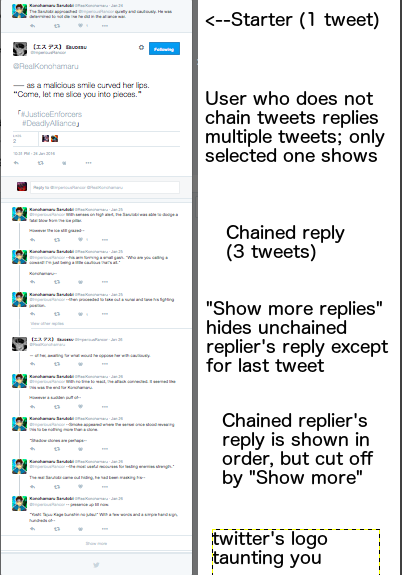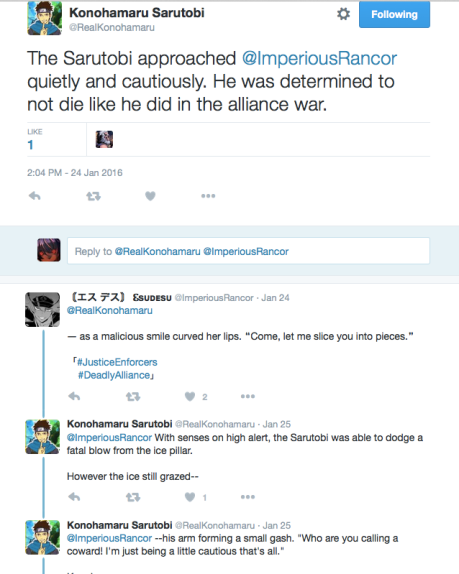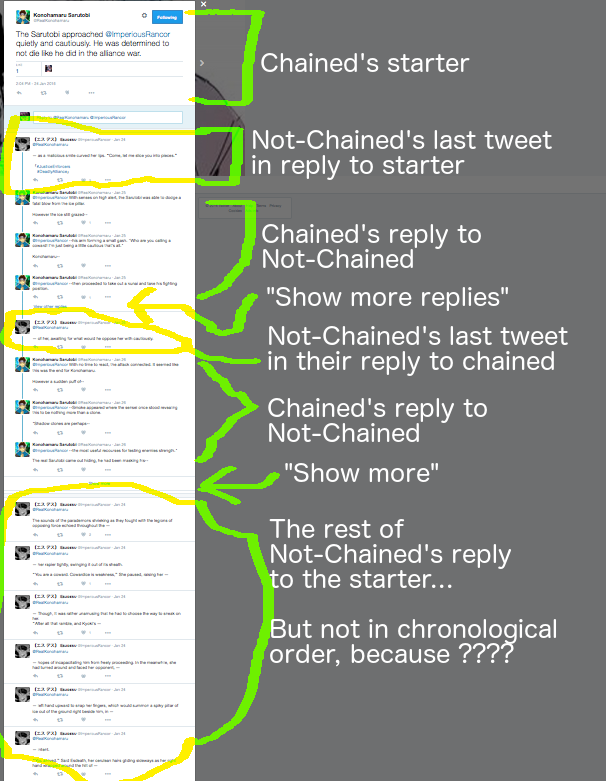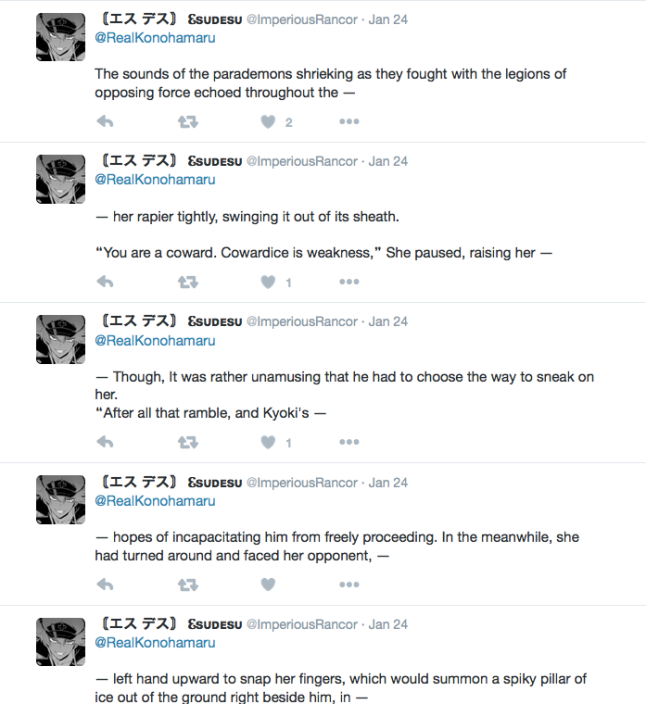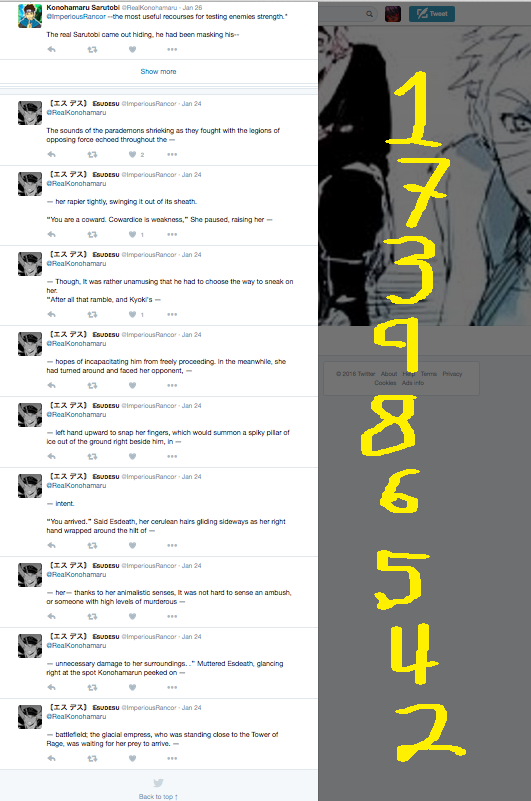Last update: July 15th, 2017.
Disclaimer: If there’s any Twitter staff reading this, I’d be happy to talk to you so any corrections can be made in this post and to clear up some misunderstandings. While I do have some issues with how the website is run–the fact it took years to make a serious effort in fighting hate speech, the fact someone I reported who harassed me and others for months is still around, the sudden UI changes with no opt-out, the “is it moderation or a glitch? who even knows” moments–I don’t have a vendetta against Twitter, its staff, or anything of the sort. I fully recognize it isn’t an easy job and that many people have jobs implementing decisions that they did not make or may not agree with.
Let’s start off with this:
IF YOU CARE ABOUT AN ACCOUNT, HAVE A WORKING EMAIL FOR IT.
Unless something has changed recently, Twitter support will almost never answer emails from emails besides the one connected to your account. You can use a mail forwarder such as 33mail, or the strategy described here, if you don’t have very many email addresses.
also (for gmail at least) foo+bar@gmail.com will redirect to foo@gmail.com, and you can apply inbox filters based on it too
— wingedcatgirl 🐱 (@wingedcatgirl) June 12, 2017
Now, let’s clear up some terminology.
Algorithm: While this technically can refer to a lot of mathematical stuff, I’m using this term to mean “any computer program that does something automatically,” such as monitoring public tweets in attempt to find spammers.
DMCA: This is basically a “cease and desist” sent by copyright holders (or, quite often, people representing them and/or their algorithms) to Twitter. Twitter is obligated under US to follow DMCAs, which means removing user content which infringes on copyright. If you get too many DMCAs on Twitter, you can get permabanned. Do not get mad at Twitter if you get DMCA’d as it as almost certainly a third party who sends the takedown. A tweet that has been DMCA’d will show up like this: https://twitter.com/carbine1996/status/756140248925544448 (Lumen database entry for this takedown: https://lumendatabase.org/notices/12806962)
Limited/locked: I’m using this phrase to mean the new “your account has been restricted” stuff that Twitter is now pulling. In this state, non-mutuals cannot see your tweets, even if you @ them. Sometimes you can’t tweet at all. Sometimes you have to delete tweets to remove the limit, other times it just lasts a certain timeframe (often 24 hours). Because Twitter tells you what’s going on, this is technically not shadowbanning.
Mutuals: People who you follow, and who follow you back.
RP/Roleplay: Hi normies reading this! I originally wrote this for roleplay accounts, but 99% of it applies to you guys too. If you don’t know what roleplay is, it’s about the nerdiest hobby ever.
Shadowbanned: This is when your account activity is limited and not everybody can see your tweets. Twitter does NOT tell you what’s going on, hence “shadow”; it’s like a ban in which you don’t know that you’re banned. Keep in mind Twitter has never confirmed that they use as a moderation tool and there is a chance it is a glitch (although I’ve seen enough evidence to indicate it actually does exist for me to believe it probably does). This is very frequently confused with the new “Your account has been limited for 24 hours” thing that Twitter is doing; because Twitter is telling you it’s doing that, it isn’t shadowbanning.
Suspended/Banned: Twitter bans your account. You cannot tweet, you cannot follow people, and your profile will show up as “This user has been suspended” to other people. In some circumstances this can be temporary and can be contested by contact Twitter support, especially if it’s done within 30 days.
Permabanned: When your account has been suspended without any hope of being recovered. This can happen if you break the rules multiple times or get too many DMCAs.
Verified accounts: Accounts have a blue checkmark next to their name. Often politicians, journalists, celebrities, etc. Verified accounts have special account features that non-verified accounts do not, such as limiting their mentions to only show other verified accounts.
Why are so many people getting banned/shadowbanned/limited now? Is it being done automatically?
The evidence shows that Twitter is using a new algorithm in attempt to fight its harassment and trolling problem. This algorithm uses a variety of factors (more on that later) in attempt to determine whether or not a user is harassing another, and it appears this algorithm does not require a human being to report the tweet/account in question. Note that there may be more than just algorithm changes and that there is some indication Twitter’s staff is actually beginning to look into reported content: Accounts that I reported for hate speech recently are getting banned now, unlike when I did the same in 2012.
Twitter has been using anti-spam algorithms for years; it is anti-harassment ones that are new and are giving people a hard time.
I’ve been hearing just swearing gets you banned. Is that true?
I have heard many claims of that, but as an account that swears a lot, it would have happened to me by now if it was just swearing and only swearing. My current hypothesis is that swearing at non-mutuals, especially non-mutual verified accounts, is where the real risk is. This includes @ mentions as well as quoting tweets.
My evidence for this is the fact that my main roleplay account uses massive amounts of swearing (I’m not talking “heck”, I’m talking multiple f-bombs in a single tweet) and has never been limited or shadowbanned as far as I’m aware, however, an account that @s a lot of people about politics does not show up in search anymore, indicating it’s been shadowbanned.
This has lead to many instances where a non-mutual verified account was being a dick, someone told them to fuck off, and that person who said “fuck off” was limited but the verified person was not. As an example:
Verified account (Notch) calling a verified account (Quinn) a cunt: No ban, shadowban, or limiting.
Stop changing your name. I had no idea it was you. Act like a cunt, get called a cunt. You were doing so well for a while there.
— Notch (@notch) June 12, 2017
Non-verified account (Spencer) responding to verified account (Notch) in response to verified account (Notch) calling someone (Quinn) a cunt: Get limited for 12 hours.
I got shadow banned for calling him an a-hole pic.twitter.com/mBIvzXIO5T
— Spencer L. (@redneptonic) June 12, 2017
(Note that the person writing this tweet calls it a shadowban, but Twitter is telling him what’s going on so it technically is not a shadowban. The main point is that Twitter’s moderation is not very well done, seems to come down heavily when swearing at verified accounts, and is not applied evenly.)
With that being said I have heard someone claim they were swearing publicly (not @’ing anybody) and seemed to have been shadowbanned, so there is a chance that swearing in general could be a factor in getting shadowbanned. I highly doubt the “if you drop the f-bomb there is a 50% chance of getting shadowbanned” thing though, because again, it would have happened to me on several accounts by now, and so many people swear on Twitter that it would be a very poor decision on their part.
How do I know if I’ve been shadowbanned?
First of all: We are not 100% sure shadowbanning exists because Twitter has never confirmed it. There’s a lot of evidence it does, though! 7/15/2017 Update: Somebody created a shadowban checker, which checks to see if your account shows up in search. Twitter has STILL not officially confirmed if shadowbanning is a thing, but I have tested a few of my accounts and based on the results, I am hesitantly saying we can now be 95% sure shadowbanning is real. The tool can be found here: http://shadownban-checker.xho.bedita.net/ Please note that as is proven in the screenshot below, even if you are NOT shadowbanned as determined by this tool, your mentions might not show up in a non-mutual’s mentions feed.
You can try @’ing an account that does not follow you. If your mention doesn’t show up on their account, you might be shadowbanned. But it is not definite, because Twitter also has a “quality filter” for mentions which might be filtering out a non-shadow-banned account’s @ from your mentions tag. As an example of a non-shadow-banned account getting one of its @’s filtered from my mentions tab:
((SPRINT ME IN THE ASS
Twitter is definitely filtering mentions on us, ugh.)) pic.twitter.com/Wzyl6ZOjMy
— 健音テイ (@Aichmomanic) September 20, 2016
Is it just me, or do verified accounts get away with a lot of this stuff? Does Twitter enforce its rules on verified accounts?
They make more money for Twitter than you do, so Twitter is a lot less likely to ban, shadowban, or limit verified accounts. It has happened before, such as with https://twitter.com/nero, although he didn’t get banned until he harassed another verified account. For the most part, they seem to get away with a lot.
What’s the full list of things that put my account at risk for getting banned?
Please keep in mind this list is based on Twitter’s rules, what I’ve seen people get suspended or banned for, and common sense. It has not been confirmed by staff at Twitter. Also note that simply doing one of these once is not a guarantee you will get banned, these are just things that might trigger a ban.
% = Against Twitter’s rules
* = Could trigger anti-spam algorithm
+ = Could trigger anti-harassment algorithm
# = Could get you DMCA’d
- Being a new account*+
- This refers to the temporal age of the account, as in, the date that you created it. Having an old account, especially if you actually use it, tends to make it less likely to get banned.
- Having a default avatar *+
- Posting links to kissanime or other anime piracy websites #
- “Stealing tweets” #
- I have seen DMCAs against parody accounts for stealing tweets from the tweets accounts of comedians. Because a DMCA is a legal notice that requires a full address of the person making the claim, it is unlikely someone will do this over RP tweets.
- Reposting art, fanart, or photography under the guise of making it yourself #
- I have not seen people get DMCA’d for this on twitter, but I have seen it on other websites
- Not having a verified email address and/or phone number *+
- Posting a ridiculous amount of tweets in a short length of time*
- Swearing at someone who does not follow you +
- “Negative sounding tweets” towards someone who does not follow you +
- There is a confirmed algorithm for “sentiment” of tweets (positive/negative/neutral), it’s available to advertisers. I’m postulating that there is a chance it could be used in moderation too
- Having pornography as your avatar or header; porn, as long as it isn’t snuff or illegal, is allowed in Tweets, but not headers of avatars %
- Posting a lot in a hashtag *
- Having few followers *+
- Having few mutuals *+
- Using automated DM services, especially ones that post links in DMs *
- Using certain hashtags used by political extremists and/or white supremacists +
- Following a lot of people, waiting for them to follow you back, then unfollowing them %
I’m a roleplayer who needs to be aggressive in a reply. How can I avoid tripping up an algorithm?
You probably won’t, but if you want to be on the safe side:
- Make sure the people you’re RPing with follow you and you follow them.
- Use narrative RP and descriptions of anger (Instead of “fuck you I’m gonna kill you”, “he looked at the other threateningly”)
- Be careful when using TwittRP and don’t use it too many times in one day.
I’m selective with who I follow because I don’t want a cluttered timeline, but I don’t want people who I don’t follow to swear at me and risk getting banned. What can I do?
Follow them, then mute them. People you follow but have muted will appear in your mentions, but not your timeline.
Can I be banned for favoriting or RTing too much?
Recently (mid-July), people have realized Twitter’s rules state that favoriting or RTing too much can be against the rules. There’s been a lot of cute memes about people insisting they will support their friends even if they get banned for it, and while that’s adorable, I think this stems from a misunderstanding.
Aggressive favoriting is a technique that is used by spambots when you tweet certain keywords, especially ones relating to sex, economics, parenting, legal help, or tech (especially Bitcoin). About a year ago, if you tweeted “sex money internship Bitcoin bail bonds Las Vegas,” your tweet would probably get at least four favs and maybe an RT from various accounts trying to get your attention. This is what I think Twitter is trying to stop.
I doubt that any reasonable amount of favoriting your mutual’s tweets will trigger this algorithm, because 1) you’re not able to fav as fast as a computer program and 2) you’re probably favoriting your mutuals, not just anybody who tweets about bail bonds.
Can I be banned for tweeting/DMing too much?
Back in 2012 this was a real issue. Roleplayers would often have “jailed” accounts that they would switch to when they hit the tweet limit. But nowadays it is very hard to hit that limit without using a program that tweets automatically.
Some people have reported being locked out posting any more DMs. It hasn’t happened to me, but I’ve heard of a few people report it, so I’m just going to say that if for some reason you can’t send DMs all of a sudden, try again in about 24 hours.
There was a time where everyone got worried about getting banned for posting anime screenshots, what happened there?
This kerfluffle was started when Funimation spammed a fansubber’s tweets of anime screenshots with DMCA takedowns, doing it so rapidly that Twitter permabanned his account before he could have a chance to remove the “infringing” content. This not merely a rumor, it is in fact public record that Funimation DMCA’d anime screenshots (somewhere around here, exact date unknown https://lumendatabase.org/notices/search?page=247&recipient_name_facet=Twitter&sender_name-require-all=true&sender_name=Remove+Your+Media&sort_by=date_received+desc&term=funimation+twitter.com&utf8=%E2%9C%93). This caused a big panic for those in the know, because it meant that Funimation believed it had the legal authority to DMCA mere screenshots of anime.
Welp. pic.twitter.com/TPAIo9vifV
— Branduil (@Branduil) February 6, 2016
//platform.twitter.com/widgets.js
However, it appears this was a one time thing that Funimation did because they were desperate to get this guy’s account banned–he did not link to pirated anime, which is what they usually DMCA people for, but had been known to work with pirated anime, so they just spammed his account’s screenshots with DMCAs. Funimation’s response to the fallout sidestepped responsibility and said that people are free to post screenshots of anime, so they’re unlikely to pull it again.
Can pornography get me banned?
If it’s in a header or avatar, yes, because that is against Twitter’s rules. Posting pornography (both “real” and hentai) in general is usually okay as long as it isn’t snuff and doesn’t involve minors. There are entire accounts dedicated to porn, as a matter of fact. Posting lewd content in text form is also allowed.
How can I harass somebody without getting banned?
Don’t, asshole.
I have evidence that something you said in here is incorrect.
Let me know, then. Keep in mind that this is pieced together using other’s people evidence and common sense, as Twitter tends to be very hush on anything that isn’t explicitly covered in its rules.
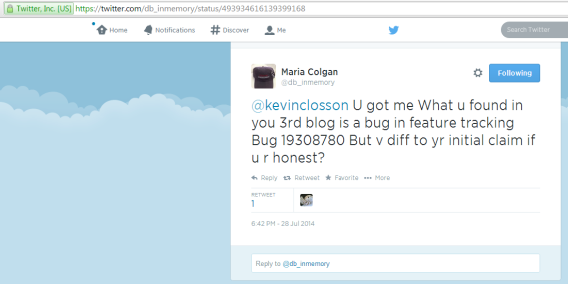
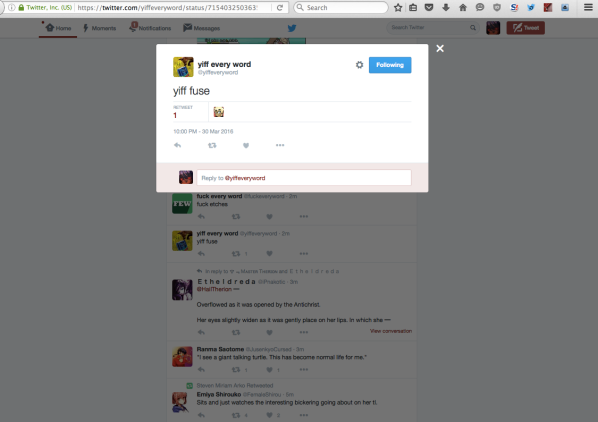
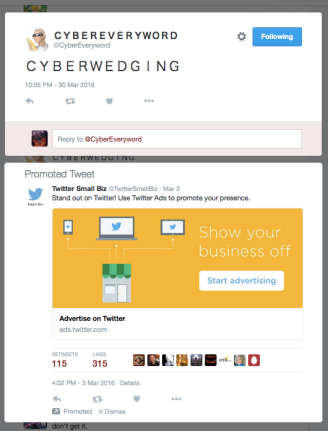 For a start, Twitter sometimes stuffs promoted content on the overlay, under the tweet that has been clicked on. Keeping in mind the timeline it is overlayed over /already/ has promoted content? That’s just flat-out gross. Not to mention covers up the timeline it is overlayed over.
For a start, Twitter sometimes stuffs promoted content on the overlay, under the tweet that has been clicked on. Keeping in mind the timeline it is overlayed over /already/ has promoted content? That’s just flat-out gross. Not to mention covers up the timeline it is overlayed over.